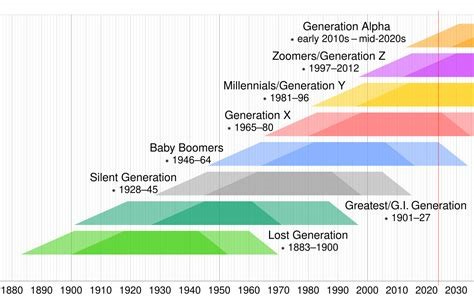Generational Theory - An Attempt to Simplify
Generations, Archetypes, and All That Other Stuff That's Difficult to Absorb
Generations and Archetypes
Generational theory explores how people born around the same time share similar experiences that end up shaping their attitudes, behaviors, and values. There are two prominent approaches, or schools of thought, regarding their concepts. Both use the common names for generations most people know – Baby Boomers – Generation X – Millenials – Generation Y – but in different ways. I have created a condensed article using Wikipedia as the base for Strauss-Howe, and will post it online at https://allinthepast.net/downloads.
Strauss-Howe Generational Theory
This theory was developed by William Strauss and Neil Howe, authors and historians. More about them below. The Core Idea of their theory is that history follows a recurring cycle of four generational archetypes (Prophet, Nomad, Hero, and Artist) over approximately 80-100 years, known as a “saeculum.” Each generation’s experiences during these turnings shape their collective persona and influence societal trends.
Their work has been both influential and controversial, with some praising their insights, while others criticizing the theory’s determinism and lack of empirical evidence.
Turnings: Each saeculum consists of four turnings:
High: A period of strong institutions and collective confidence.
Awakening: A time of spiritual upheaval and questioning of established norms.
Unraveling: A time when institutions weaken, and individualism rises.
Crisis: A decisive era of upheaval and reconstruction.
William Strauss was a writer, historian, and playwright. Along with Neil Howe, he co-authored several influential books, including “Generations: The History of America’s Future, 1584 to 2069” and "The Fourth Turning: An American Prophecy". His work focused on generational cycles and their impacts on American history and society.
Neil Howe is a historian, economist, and demographer. He has worked extensively on generational studies and co-authored the books with Strauss, providing a comprehensive analysis of generational patterns and their implications. His research has been influential, primarily in marketing, business management, and social sciences.
Summary
An average modern life is 80 years and consists of four periods ~20–22 years long --
Childhood → Young adult → Midlife → ElderhoodA generation is an aggregate of people born every ~20–22 years --
Baby boomers → Gen X → Millennials → HomelandersEach generation experiences four “turnings" every ~80–90 years --
High → Awakening → Unraveling → CrisisA generation is considered "dominant" or "recessive" based on the turning experienced as young adults. As the youth generation comes of age and defines its collective persona, an opposing midlife generational archetype is at its peak of power --
Dominant: independent behavior and attitudes define the era
Recessive: dependent role defines the eraDominant generations --
Prophet (idealist): Awakening as young adults; institutions are attacked in the name of personal and spiritual autonomy
Hero (civic): Crisis as young adults; institutional life is destroyed and rebuilt in response to a perceived threat to the nation's survival
Recessive generations --
Nomad (reactive): Unraveling as young adults; institutions are weak and distrusted, individualism is strong and flourishing
Artist (adaptive): High [when they become] young adults; institutions are strong and individualism is weak
Sources:
Strauss-Howe Generational Theory
The Fourth Turning: An American Prophecy
The Fourth Turning - Google Books
Karl Mannheim’s Theory of Generations
Karl Mannheim’s Theory of Generations, presented in his 1928 essay “Das Problem der Generationen” (translated into English in 1952 as “The Problem of Generations”), is a fundamental concept in Sociology. As the chart above indicates, this theory might be more familiar to many people, although the names for the generations are basically the same between the two theories.
Core Ideas
· Generational Location: Mannheim theorized that individuals born around the same time share a “generational location,” meaning they experience similar socio-historical events during their formative years.
· Generation in Actuality: Not all generational cohorts develop a distinct consciousness. For a generation to become a “generation in actuality,” significant historical events must impact them during their youth
· Generational Units: Within a generation, different groups (or units) may respond differently to the same events, leading to diverse sub-groups with unique perspectives.
Influence of Historical Context
· Social Change: The pace of social change influences whether a generation develops a distinct consciousness. Rapid social changes are more likely to produce distinct generational identities.
· Shared Experiences: Major historical events shape the collective consciousness of a generation, influencing their attitudes, behaviors, and values throughout their lives.
Applications
· Sociology: Mannheim’s theory helps explain how social movements and cultural shifts occur while maintaining continuity with past traditions.
· Interdisciplinary Impacts: The concept of generations has been used in several fields - demography, psychology, and anthropology - to study intergenerational relationships and social dynamics. The theory remains influential in understanding how historical events shape the collective identity and behavior of different age cohorts.
· Sources:
Theory of Generations - Wikipedia
The Concept of Generations - Oxford Bibliographies
Are Generational Categories Meaningful? - National Academies Press
General Applications of Either Generational Theory
Sociology and History: Understanding generational dynamics helps explain social changes and historical patterns.
Marketing and Business: Companies use generational insights to adapt their products and services to different age groups.
Politics and Policy: Policymakers consider generational perspectives to address societal needs and preferences.




